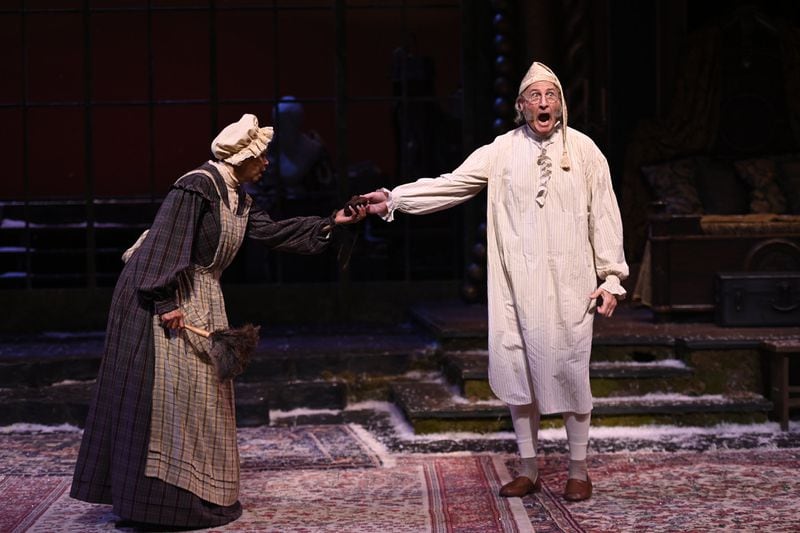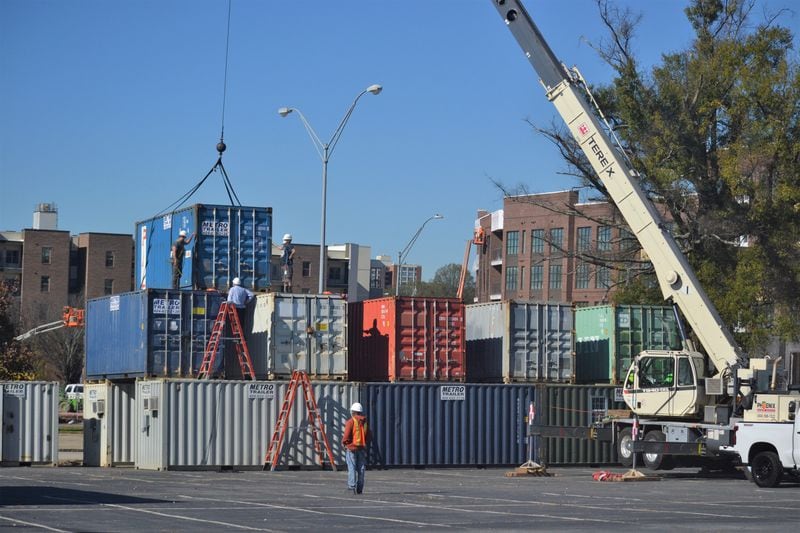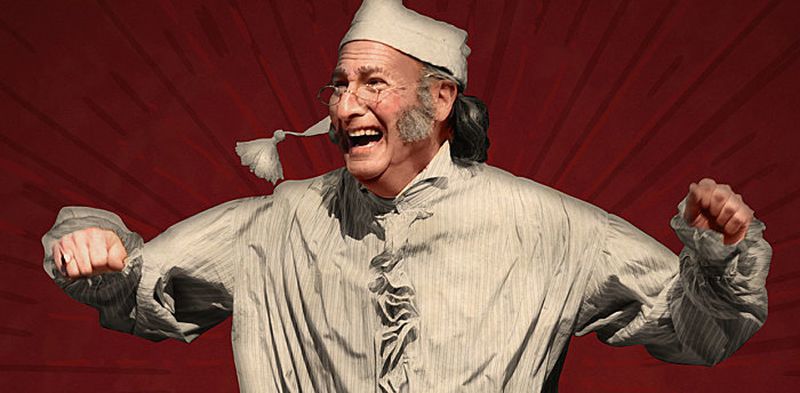If you fool with a holiday classic, you do so at your own peril. No one wants to see Santa Claus in a Speedo.
But desperate times call for desperate measures.
Every year the Alliance Theatre production of the Charles Dickens novella, “A Christmas Carol,” with dozens of cast members, big sets and elaborate costumes, is its biggest moneymaker and crowd-pleaser.
In the era of COVID-19, things had to change. So, artistic director Susan V. Booth, scenic and costume designer An-Lin Dauber, and co-adapters Leora Morris and Ben Coleman brainstormed.
Could they still do the show by moving it outdoors? How could they perform outdoors in the winter? How could they keep the cast safe?
What they came up with is an outdoor presentation of a live, drive-in radio play, in a football stadium parking lot, with only four cast members in a stark, post-industrial set.
In appearance, the new production, “A Christmas Carol: The Live Radio Play,” is a far cry from the warm fuzzy holiday special that Atlanta loves. But appearances can be deceiving.
“Here’s the thing,” said the Alliance’s managing director Mike Schleifer. “We had to make a choice with the pandemic: We could hibernate, or we could navigate.”
The original idea was to have a small group of actors on an outdoor stage with their images thrown onto a large movie screen — turning the play into a drive-in movie.
They needed separation between the actors and a cover in case it rained to protect the actors and the sound equipment. This meant building a stage with a roof, and a screen on top. But a screen big enough to be seen from the back row and a projector strong enough to produce the image would be costly. And then what about a 40 mph wind that could turn that screen into a sail? “What kind of engineering is going to make that happen?” asked Schleifer, who has to count the beans for these productions. “We can’t afford it.”
Credit: Kathleen Covington
Credit: Kathleen Covington
Then, either Morris or Dauber (or both) came up with an idea that would solve many problems at once. Put the actors each in their own shipping container, with the open end facing the audience. They would be nicely separated; they’d have a roof over their heads, and they’d be able to lock their stuff up at the end of the day.
Bonus: the three-layer ziggurat of stacked containers would provide a dramatic setting.
Gradually, the production turned away from images and toward voices. They began modeling their concept on the radio plays of the 1930s and ’40s, complete with voice actors, live musicians and a Foley artist creating sound effects. This could, paradoxically, bring the audience closer to the action.
“COVID has imposed not just a fourth wall but a 20‐foot‐deep fourth wall for all of us,” said Morris, speaking from her home in a rainy Vancouver, Canada. “We wanted to find ways to create intimacy. Piping our voices into people’s cars was a way to do that. You’re witnessing something far away, but it feels like you’re wrapped in it. It’s in the car with you. It’s inviting you to commune with it.”
Consequently, the screen became less important. Instead of seeing the story, the audience would hear it, while small screens project the storytellers’ faces, along with a screen showing the acoustic gymnastics of sound effects expert and percussionist Stuart Gerber.
Credit: Sacha Blackburne
Credit: Sacha Blackburne
Gerber is a professor at Georgia State University and a performer with the experimental music ensemble Bent Frequency. On stage, he will have his own shipping container cubbyhole, outfitted with cameras, microphones and a space heater. It will also be stuffed with devices: bells, chimes, bird whistles, a “squeak box,” a miniature door to open and close, cellophane to crinkle for the sound of a fire in the fireplace, a wind machine with a hand crank, coconut shells for the sound of a trotting horse and a metronome that becomes, for Scrooge, the telltale, terrifying sound of onrushing death.
On the fourth day of rehearsals, the small cast gathered online to run through an early section of the play, all of them arranged in a grid of Zoom squares, like members of the Brady Bunch.
First, they sang, a cappella, a few bars of the French carol, “Bring a Torch, Jeanette, Isabella.” All the cast members sing and will bring madrigals and carols to the show.
Then, they dived into a scene in which Scrooge is whisked to his childhood by the Ghost of Christmas Past. There, he sees himself as a baby in his mother’s arms, then as a schoolboy, wandering through a frozen field, past a henhouse, and encountering his schoolmates who are headed off to holiday.
“Stuart has some great walking‐in‐the‐snow sounds,” Morris told the troupe. Gerber, in his Zoom square, could be seen standing near an overhead mic, creating snowy footsteps by rhythmically crushing an unopened packet of graham crackers.
“OK, we’re about to build the chicken sounds,” said Morris, asking for volunteers. Cast member Jeremy Aggers, who also plays guitar and banjo in the production, said, “This may come as no surprise to anyone, but I can do a pretty good chicken impression.”
“I was saying earlier,” said Morris, “we found the show for all your sounds.”
“It’s a dream come true,” said Aggers. He produced a few gentle squawks.
“How about an agitated chicken?” asked Morris. Aggers gave voice to a more overwrought yardbird, joined by Jeanette Illidge.
In the meantime, Gerber produced flapping feathers by shaking a feather duster and a thin folio of sheet music (a Bach composition) next to a microphone.
Above this henhouse symphony, Brad Raymond recited lines in his Scrooge voice, exclaiming with delight, “I used to chase these chickens!” Scrooge soon despaired as he called to his childhood schoolmates, who walked off without hearing the disembodied spirit.
Raymond has been part of the Alliance’s “A Christmas Carol” productions for years, but this version, which gives him nine different roles in addition to Scrooge, will test his skills as a voice actor.
“The audience is really going to be surprised by the fact that there are only three voice actors and one percussionist for a story with at least 80 different characters in the show,” he said.
For inspiration, Coleman and Morris hopscotched through oral traditions, drawing on Homeric poetry, standup comedy and baseball announcers, as well as radio drama, when adapting the script.
Coleman is a British musician who performed with Atlanta bands Judi Chicago and Noot d’Noot and has worked creating soundscapes for theatre, dance and the visual arts.
Morris served as a Yale Directing Fellow at the Alliance after graduating from the Yale School of Drama and then stayed with the Alliance for several years as the resident artist in education.
Morris and Coleman worked together last fall, creating an Alliance production for the Kathy & Ken Bernhardt Theatre for the Very Young (including babies) based on the children’s book by Maira Kalman, “Hey Willy, See the Pyramids.”
Speaking from his home in Denver, Colorado, with blue skies above and snow below, Coleman said the experimental quality of the show drew him to the production. “I wouldn’t be nearly as interested if this was a more conventional staging. I appreciate the fact that the Alliance is willing to take this risk. Something wonderful will come out of this.”
What won’t come out of this is the Alliance’s reliable holiday moneymaker. The Summerhill parking lot, outside the former Braves stadium (now called Georgia State University’s Center Parc Credit Union Stadium), can hold 120 cars, versus the 650-seat capacity at the Alliance’s brand-new Coca-Cola Theatre, which remains empty and dark.
The show will cost less to stage, but it still won’t break even, said Schleifer. He added, “What’s important to us right now is to stay relevant.”
Credit: From cobbenergycentre.com
Credit: From cobbenergycentre.com
Like many arts organizations, the Alliance has been streaming shows online, including “A Very Terry Christmas,” a one-woman show which kicks off the season Nov. 27. This production of “A Christmas Carol” will be its first live event since the beginning of the pandemic, and one of only six live productions in the country approved by the Actor’s Equity union, according to Schleifer. They won approval because of the company’s stringent protocols protecting the actors and the audience.
Unlike streamed material, this show announces the predicament of the pandemic in its stage design. The actors, like us, are kept separate, in their boxes. It’s a bleak image.
But by the end of the one-act performance, the audience is honking its horns in unison, singing along, flashing headlights, connecting with the drama. (Just as Scrooge, “as solitary as an oyster,” also comes out of his shell.)
“This is us,” said Schleifer, “coming out of an isolation.”
“It’s a classic story,” said Gerber. “It’s hopeful at the end. It should reflect what we’re going to see next year. Pretty soon this will be Christmas past, and that will be a good thing.”
IF YOU GO
- Two parking spaces are dedicated to each vehicle. Patrons may sit outside their vehicle or stay inside.
- Food delivery is available by ordering in advance from Hot Dog Pete’s (470-369-6777) or Hero Donuts and Buns (470-369-6800).
- Coolers, alcohol (for those age 21 and up), binoculars, blankets, tarps, cameras without a detachable lens, cans, coolers, face masks, prepared foods, lawn chairs and water bottles are permitted.
- Cameras with a detachable lens, fireworks, flags, glass bottles, grills, illegal drugs, inflatables, large vehicles, pets, signs, banners, tents and weapons are prohibited.
- No audio or video recording allowed.
THEATER PREVIEW
‘A Christmas Carol: The Live Radio Play’
Presented by the Alliance Theatre.
7 p.m., Dec. 4-23. Parking lot opens 5 p.m. $50-$175 per car.
Georgia State University’s Center Parc Credit Union Stadium, 755 Hank Aaron Drive, Atlanta.
The production will also be streamed on Alliance Theatre Anywhere beginning in early December. $20, alliancetheatre.org.
About the Author
/cloudfront-us-east-1.images.arcpublishing.com/ajc/BHUCDJXXATPZGLXUKRNHCFOKLM.jpg)










